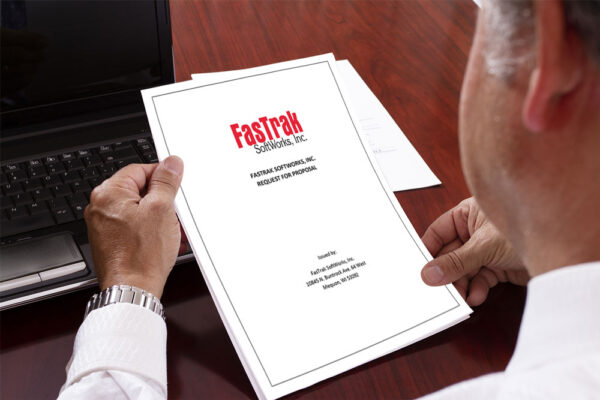
Investing in a computerized maintenance management system (CMMS) is a critical step in modernizing your maintenance operations, so it pays to get the decision right. With countless options available, organizations often struggle to know how to properly compare solutions against one another. Using a request for proposal (RFP), organizations can formally communicate their requirements, standardize vendor bid responses, and make a confident, informed software choice.
This article walks you through the role of the CMMS RFP in the procurement process and shows you how to use it to select the best maintenance management system for your organization.
What is a CMMS RFP?

request for proposal (RFP) is a formal document written by the buyer’s organization that describes a project’s requirements and invites qualified vendors to submit a bid. They are typically used by organizations for big purchases and complex projects that require outside help, technical expertise, or specialized capabilities to complete. When used as part of the procurement process, an RFP helps organizations fairly evaluate vendor products and service offerings.
RFPs are commonly used for CMMS software purchases because implementing a CMMS fundamentally changes how organizations manage their maintenance operations, costs, and processes. With such high stakes, it is critical to thoroughly and fairly evaluate solutions to minimize risk, maximize long-term value, and ensure alignment with their maintenance management goals and unique operating environment.
Not every organization needs to issue an RFP when purchasing a CMMS. RFPs are most often used by large organizations with complex maintenance operations, government agencies, or highly regulated industries that require a documented, competitive bidding process. Smaller organizations or those with simpler requirements may use a more informal evaluation process. However, they may still choose to create an RFP because it provides structure, encourages fair comparisons, includes stakeholder feedback, and provides documentation that justifies the CMMS purchase.
RFP vs. RFI
Organizations may send out multiple documents to CMMS vendors, including a request for information (RFI) and request for proposal (RFP). Each plays a specific role in the CMMS buying process:
- A request for information (RFI) is a document intended to qualify candidates by asking potential vendors for general information about their products and services. It helps organizations understand what products and services are available and narrow down the pool of candidates who will be sent the RFP.
- A request for proposal (RFP) is a formal document that asks vendors to submit bids on the project. Going deeper than an RFI, an RFP may ask about a company’s background and experience, client references, and financial stability, as well as the proposed solution, pricing, and implementation timelines.
Benefits of a CMMS RFP
Using an RFP provides a framework for evaluating CMMS vendor solutions. Below are some reasons you may consider using a CMMS RFP, even if it is not strictly required:
- Establishes a structured process: The RFP process forces organizations to document requirements in a clear, organized way, and forces organizations to think through their maintenance needs, priorities, and goals.
- Aligns maintenance priorities with business goals: Creating an RFP requires input from multiple stakeholders across multiple departments, ensuring maintenance needs are aligned with organizational priorities and long-term goals.
- Encourages fair evaluation: An RFP standardizes responses so organizations can compare CMMS solutions apples-to-apples.
- Improves vendor communication: A CMMS RFP clearly conveys your requirements and expectations, which reduces misunderstandings and ensures vendors tailor their solutions to fit your needs.
- Provides documentation for decisions: A CMMS RFP provides a reference document that describes why a vendor was chosen, which helps justify the selection to leadership, decision-makers, and other stakeholders.
- Minimizes risk: The RFP process reduces the likelihood of selecting a CMMS that doesn’t meet your needs.
Though there are many benefits to using an RFP, it may not be appropriate for all organizations. While advantageous, creating an RFP requires significant time and effort – even more so from organizations with little RFP experience. For organizations with simple maintenance needs or immediate implementation deadlines, direct vendor research may be more time- and cost-effective.
The CMMS RFP Process

A CMMS RFP outlines the project’s requirements, but writing the document is only one part of the process. The steps below describe a typical CMMS RFP process. Procedures will vary depending on your organization’s size and sector. For example, government agencies usually follow a more thorough process than medium-sized private companies.
- Clarify Needs and Goals
Before drafting the CMMS RFP, meet with key maintenance stakeholders to clarify maintenance needs, goals, and project timelines. Documenting these requirements ensures the RFP accurately reflects organizational priorities and operating environment. - Create a Preliminary Vendor List
Some organizations send out a request for information (RFI) to gather high-level vendor details. This helps screen potential candidates and narrow the pool of vendors before sending out the formal CMMS RFP. - Write the CMMS RFP
Develop the formal RFP, including detailed descriptions of your maintenance needs and solution requirements. Provide a standard set of questions for vendors to answer, and allow room for them to highlight unique strengths. This step often requires several rounds of review to strike the right balance between clarity and detail. - Distribute the CMMS RFP
Send the RFP to the CMMS vendors on your shortlist and allow time for any follow-up questions as they review your requirements. - Evaluate Responses and Create a Vendor Shortlist
Review incoming proposals and score them against your requirements. The goal is to narrow the list to the top 2-3 vendors. - Evaluate Finalists and Schedule Demos
Schedule software demonstrations with your finalists, ask clarifying questions, and request detailed pricing and service information if not already provided. Key stakeholders should participate in demos to evaluate functionality, technical fit, and usability. Learn what to expect in a CMMS software demonstration. - Make a Decision
With your project team, review all information and select the vendor that best meets your needs. In many organizations, maintenance leadership must recommend a solution to executives or other decision-makers before approval. Once the decision is finalized, notify the chosen vendor as well as those not selected.
Following a structured RFP process ensures your organization makes an informed, confident CMMS investment decision.
Prepare to Draft a CMMS RFP
A strong CMMS RFP results in higher-quality vendor responses. That’s why thorough preparation is essential before writing the formal document. While preparation requires time and effort, it provides clarity, keeps your project on track, and makes the writing process more efficient. Below are some steps to consider before drafting your CMMS RFP.
Identify Your Pains and Goals
The search for a CMMS typically begins with the need to solve challenges or improve maintenance operations. With many opportunities for improvement, it can be difficult to know where to focus. Work with your CMMS project team to identify your biggest pains, prioritize goals, and outline how you expect a CMMS to address them.
Gather Key Project Details
Your CMMS RFP should reflect practical factors like budget and timeline, which may influence the vendors with which you engage. These details help you evaluate vendor responses realistically and prevent wasting time on vendors who can’t meet your requirements.
You also need a plan for managing the CMMS RFP process. Consider who will be in charge of the project, communicating with vendors, reviewing proposals, and keeping the project on track.
Understand CMMS Deployment Options
A major decision that will shape vendor proposals is whether your CMMS will be deployed in the cloud or on your local servers. This choice affects licensing, pricing, implementation services, and project timeframe. Larger or highly regulated organizations often prefer (or require) on-premise CMMS, while small to medium-sized organizations with simpler maintenance needs commonly choose cloud-based CMMS solutions.
Writing a CMMS RFP: Key Sections to Include
A well-structured CMMS RFP ensures vendors understand your needs and can provide tailored responses. While every RFP may look different, each typically includes the following sections:
Project Overview
The project overview summarizes the project’s goals, scope, and desired outcomes, as described in the other sections. This gives vendors a quick way to understand what you’re trying to accomplish.
Company Background
This section provides vendors with some context about your organization, including what you do, who you serve, and how maintenance supports your operations. Including other information about the size of your maintenance team and number of assets you maintain helps vendors further align their solutions with your operating environment.
Business and Technical Requirements
In this section, outline the specific needs the CMMS must meet. Requirements often fall into business requirements and technical requirements.
Business requirements are related to the CMMS’s functionality and what processes you wish to improve, such as work order management, preventive maintenance, MRO inventory management, and so on.
Technical requirements describe your organization’s IT infrastructure, and may include details such as:
- Computer platform (Windows or Mac) and operating system
- Types and number of devices on which the software will be used
- Current maintenance system being used, if any, and any systems you may wish to integrate with the CMMS
- Special hardware or software being used
- CMMS deployment preference (cloud or on-premise)
- Number of users who will access the system and their roles (e.g., system administrator, primary end user, requester, etc.)
- Number of locations in which the software will be used
- Any other limitations of constraints
| Helpful Hint: We often find that the RFP’s we receive for FTMaintenance Select are missing details about users. If vendors don’t know what software usage will look like, it will be difficult to provide accurate pricing and licensing information. Make sure your CMMS RFP includes an estimate of current and future users, their roles, and number of locations that will use the CMMS. |
Project Goals
The Project Goals section is where you describe your ideal outcome with the CMMS. It helps vendors see your vision of success, and provides them with valuable insight into how their solution can help you. The more clearly you explain your vision, the more likely you are to get what you want.
Product Requirements
Product requirements are the specific features and functionality your organization requires of a CMMS. This is typically communicated through a spreadsheet that allows vendors to indicate whether their solution meets the requirements using a checked box or rating scale. You may also include an additional column for vendors to provide long-form answers.
| Helpful Hint: Although envisioning your CMMS is exciting, it is easy to get carried away and add wish list items or “nice-to-haves” to your product requirements. To avoid adding the “kitchen sink,” focus on the true “hard” requirements that you must have in a CMMS solution. If you feel the need to include wish list items, list them separate from your core requirements. |
Service Requirements
Service requirements list the implementation services and support you will need from the vendor to launch your CMMS. This is especially important for first-time buyers or organizations with little implementation experience. When thinking about your service requirements, consider questions like:
- Does your organization have implementation experience?
- What type of CMMS training do you prefer – in-person at your facility, in-person at the vendor’s location, or online?
- Does your organization have technical experts?
- What level of customer support do you require?
- Is there a need for additional services such as integration or custom development?
Budget
Letting vendors know what you’re able to spend on the CMMS helps them determine whether they can provide a solution at that price, or what product and service tiers to recommend. Even if you can only provide an estimate or range, you don’t want to waste your time (or the vendor’s) by entertaining a solution that will ultimately be unattainable.
Procurement Schedule
The procurement schedule provides vendors with milestone dates for your project, including due dates for vendor responses, when short-listed vendors will be notified, when demonstrations will be scheduled, and when the finalist will be selected. Not only does this ensure that your project stays on track, it helps vendors prepare presentation materials should they be selected.
Selection Criteria
Each vendor will have different strengths, weaknesses, capabilities, and experience. Before you begin, decide as a team which factors are most important, such as functionality, price, implementation support, training, vendor qualifications, etc., and communicate those criteria to vendors.
To remain fair in evaluation, develop a rubric or scoring system that allows you to rank vendors against each criterion. Sharing these details with vendors helps them tailor their responses more effectively. For example, instead of restricting them to simple Yes/No checkboxes, allow space for explanations. This gives you a clearer picture on how well each solution meets your needs.
Submission Requirements
Submission requirements provide details about how and when proposals are to be submitted. Consider questions like:
- Who will be the point of contact?
- How should proposals be sent – by mail or electronically?
- Will you take questions during the process?
Common CMMS RFP Mistakes (and How to Avoid Them)

Even with careful attention to detail, organizations often make mistakes when creating a CMMS RFP that can limit their chances of finding the right solution. By being aware of these pitfalls ahead of time, you can avoid them and ensure your CMMS RFP attracts accurate, useful proposals that make vendor comparison easier. Below are some of the most common CMMS RFP mistakes and how to avoid making them.
Overspecifying Requirements
One of the most common mistakes in writing a CMMS RFP is overspecifying how the solution must work. Listing too many detailed requirements narrows the vendor pool, discourages qualified providers, and may prevent you from finding an acceptable system.
Solution: Focus on fundamental requirements instead of how the functions are performed. Rather than getting caught up in how you need the system to work, define the results you want and give vendors the flexibility to propose the best way their system can meet your goals.
Inappropriate Length (Too Short or Too Long)
RFPs must strike a balance between too much detail and too little. If your CMMS RFP is overly brief, vendors won’t have enough context to provide meaningful proposals. On the other hand, excessively long RFPs can overwhelm or discourage vendors from responding.
Solution: Focus on clarity and completeness. Instead of targeting a certain page length or word count, focus on including all the information vendors need to understand your goals and requirements, but avoid unnecessary detail or filler. Review past RFPs from your organization (if available) or reference online templates for guidance. As a benchmark, private-sector RFPs often fall between 15-20 pages, while government RFPs tend to be longer due to legal and compliance requirements.
Ignoring Stakeholder Input
CMMS RFPs developed without input from key stakeholders often leave out or misrepresent important details, such as budget limitations, go-live timelines, IT capabilities, and security requirements.
Solution: Involve stakeholders across all levels of the organization. Including all perspectives ensures the RFP reflects real-world needs and increases buy-in from decision makers who must ultimately approve and support the CMMS purchase. For example, while maintenance teams can provide insight into day-to-day needs, the IT team can outline technical requirements, and executives can confirm budget and strategic alignment with other business goals.
Delaying Communication with Vendors
Poor communication during the RFP process delays response submissions, slows down evaluations, and frustrates vendors. Without a clear channel for questions, deadlines for responses, or expectations for how information will be shared, vendors may submit incomplete or inaccurate proposals.
Solution: Establish a communication plan. Clearly state how and when vendors can submit questions, the format (e.g., email, scheduled Q&A sessions, etc.), and whether answers will be shared with all participants. Keeping communication organized helps prevent delays and ensures every vendor has the same information to work with.
Making the RFP Too Self-Focused
While it is important to inform vendors about your business, many organizations feel that they need to reveal everything about who they are and what they do. This can overload the RFP with unnecessary details and shift focus away from your requirements.
Solution: Keep your CMMS RFP vendor-focused. For example, instead of giving vendors a complete company history, provide only the background information necessary for vendors to understand your needs. A well-balanced RFP gives vendors just enough context to respond effectively. If they want more information, they will look at your website or ask follow-up questions.
Using a Confusing Evaluation System
Another common mistake is failing to create a plan for how responses will be compared, or creating an evaluation system that is confusing, inconsistent, or poorly defined. Without a clear, fair method for evaluating vendor responses, it becomes difficult to objectively determine which CMMS solution best meets your needs.
Solution: Develop a standardized scoring system or rubric. A well-defined evaluation system ensures fair comparisons, reduces bias, speeds up decision-making, and gives all stakeholders confidence that the selected vendor truly meets your organization’s requirements. Be sure to communicate the evaluation criteria and weighting to vendors so they understand how their responses will be assessed and can tailor their proposals accordingly.
Allowing Too Many Freeform Responses
Allowing vendors to answer every question in freeform may seem helpful, but it is a common RFP mistake. Unlimited open-ended responses can result in answers that are either too long to evaluate or too short to provide meaningful information. That said, some freeform responses are important for questions where multiple-choice or yes/no options would produce inaccurate or forced answers.
Solution: Pair freeform fields with structured responses. Use multiple-choice, yes/no checkboxes, and other limited-option questions for standard requirements, and include freeform fields where additional context is necessary. For example:
- Freeform: “What key features does your software have that differentiate it from competitors?”
- Yes/No: “Do you offer a mobile app for your product?”
This approach balances clarity for evaluation while giving vendors the opportunity to explain unique aspects of their solution.
Consider FTMaintenance Select as Your CMMS Solution
Creating a thoughtful, well-structured CMMS RFP is a critical step in selecting the right maintenance management solution for your organization. By going through a formal RFP process, whether required or voluntary, you increase the likelihood of receiving high-quality vendor proposals.
For organizations looking for a reliable, powerful CMMS, FTMaintenance Select offers a robust, feature-rich platform for managing, documenting, and tracking maintenance activities. Whether you are a small maintenance team or a large, regulated organization, FTMaintenance Select can help you extend asset lifecycles, maximize efficiency, and reduce maintenance costs. Request a demo of FTMaintenance Select today to see how our solution can address your maintenance challenges and support your long-term goals.